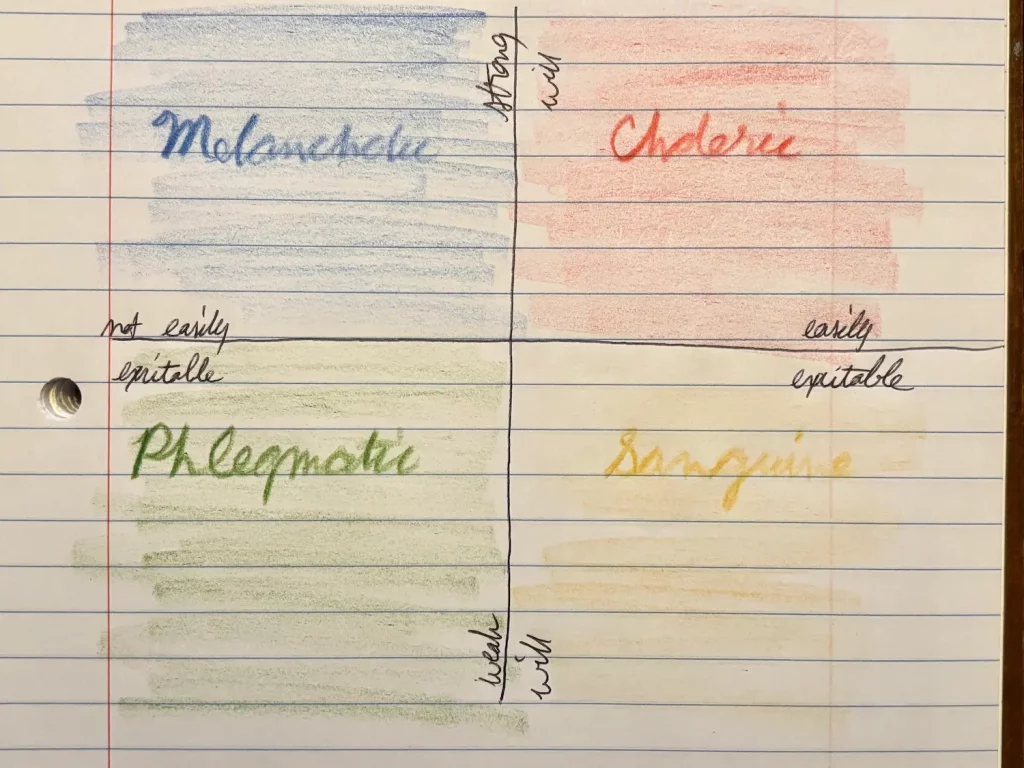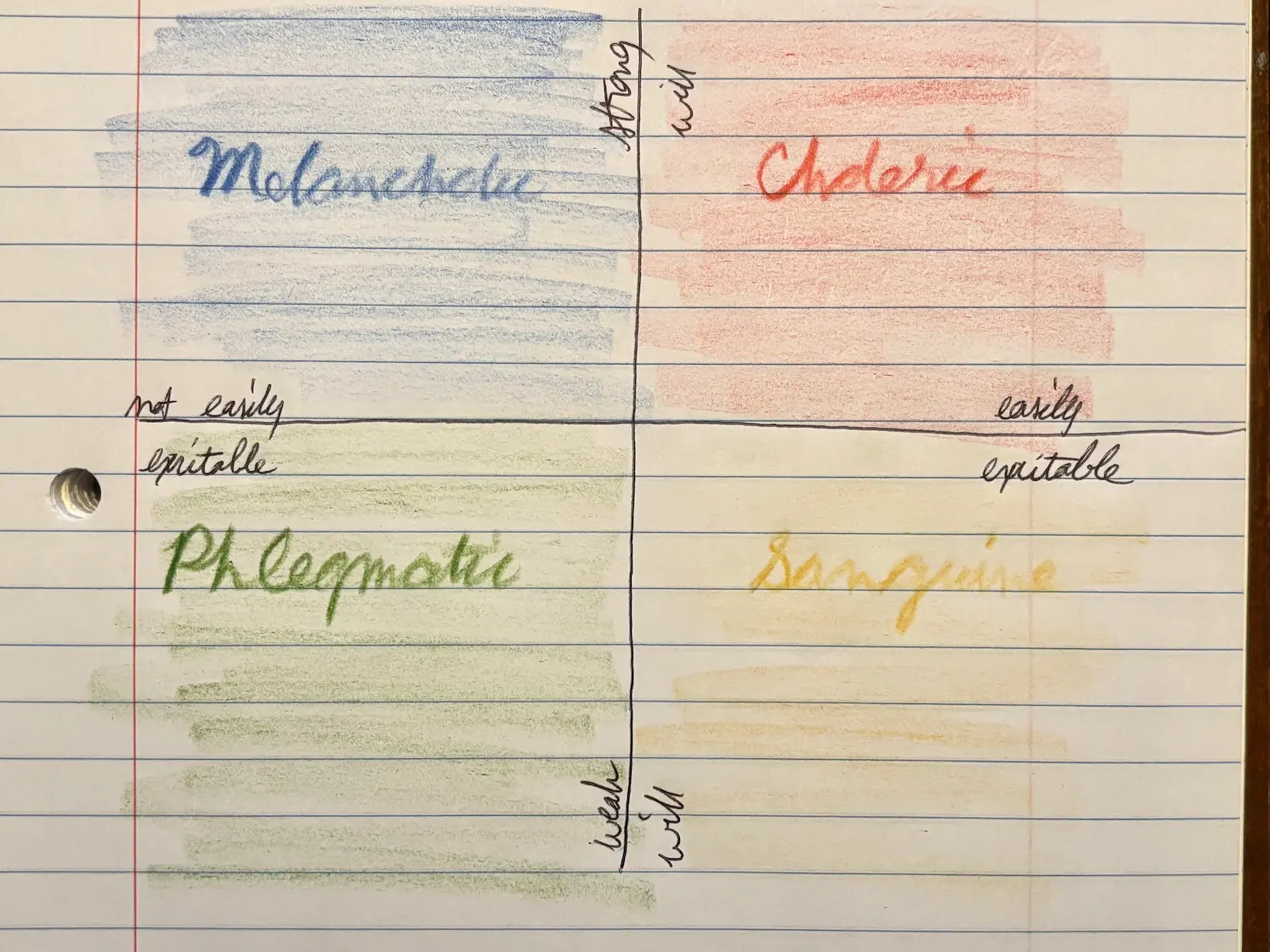In this first of two posts, we will examine the four temperaments in education. For Part I, we will characterize each of the four temperaments. In Part II next week, we will look at how to work skillfully with them.
To begin, what is a temperament and where does it come from? To answer that, we need to consider the fourfold human being. Going back to ancient times, both the Indian and Greek systems understood the manifest universe to be composed of earth, air, water, and fire. Strictly speaking, both systems also had a fifth element of space for the Indians and life for the Greeks. That being said, the four temperaments are based on the first four of these elements with the fifth being, perhaps, the one which ties them all together.
We can extend these elements to the four members of the human being – physical body, etheric or life body, astral or sensation body, and the Ego or individuality. We can chart the correspondences as below:
- Earth – Physical – Melancholic Temperament
- Water – Etheric/Life – Phlegmatic Temperament
- Air – Astral/Sensation/Experience – Sanguine Temperament
- Fire – Ego/Individuality – Choleric Temperament
With the fourfold human being in mind, let us proceed.
The Fire – Choleric Temperament
During the French Revolution, a starving crowd had gathered at the royal palace angrily demanding bread. A young, short French officer named Napoleon commanded them to disperse or he would command his soldiers to open fire on them with canons. They refused, so he fired.
This extreme example characterizes the archetypal choleric persona – a mighty personality in a short body. In fact, the reason many choleric individuals are shorter of stature is that the ego-individuality is so dominant even from a young age that it actually stunts the growth of the physical body.
Choleric people are the leaders of society. They are the children who will happily move a big pile of wood across the playground. They are the George Steinbrenners storming through the locker room on a rampage because their Yankees are only up 3-1 in the World Series instead of 4-0. Dominated by fire, these people need to be in charge. They need to be out front and in the lead.
The Air – Sanguine Temperament
I once went out for a night on the town with my colleagues from Asheville Waldorf School. We were following Tom, a fellow grades teacher, because he knew where the action was. He knew where everything was in town. In fact, he probably knew everyONE in town. It should then be clear why it took us about 25 minutes to walk two blocks. He talked to pretty much everybody he knew and even didn’t know along the way, laughing it up as he went.
In Tom we have a picture of the characteristic sanguine. Always the gregarious one and so easily distractible, Tom was the life of the party. He was friendly to everyone and also concerned that others around him were feeling good, seeking to brighten their day if they were not.
It also took Tom about an hour to write an email of a few sentences. Sometimes in faculty meetings, he would start on one thought and then interrupt himself to start a second thought about something totally unrelated before even finishing the first. Dominated by the astral body and the hunger for experience of all kinds, this is the sanguine temperament. It flits from sensation to sensation, never dwelling on any one for too long.
The Water – Phlegmatic Temperament
I have a friend who is quiet and pretty much always content. She rarely complains about anything, and she’s quiet not because she’s shy. It’s because she is so well as a general rule that she doesn’t have much to say. And, she likes food. A lot.
The regular rhythms of the lymphatic system govern the phlegmatic temperament. That is why they love regularity, routines, and rules. You will always know the phlegmatic children in your class because at least 50% the questions they ask are, “Is it snack time yet?”
The phlegmatic is the hardest temperament to arouse. However, if on the rare occasion you incur their wrath, it is truly something to behold. Governed by water, they can become like a tidal wave and you do not want to be in their path. The choleric gets angry often and fizzles out quickly. The phlegmatic gets angry rarely, but causes a tsunami.
The Earth – Melancholic Temperament
We all know at least one melancholic, you know, the person who’s always in some kind of pain. I don’t necessarily mean chronic physical pain, I just mean pain in general. Things are never fully okay, and you wonder if they’ve ever truly been happy. Oh yes, there was that one time five years ago when they had the best day of their lives, and the most you got from them was, “Yeah, things are okay. Not as bad as they could be.”
I’m exaggerating a bit – most melancholics are not that dramatic, but the the physical body dominates this temperament. The physical body would be a dead stone if it weren’t animated by life, and so these people are characterized by a kind of heaviness. They dove perhaps a little too deep when they incarnated, and they feel the weight of the world.
They also feel others’ pain, and their virtue is compassion. The melancholic also penetrates things deeply. The depth of their study and meditation on a subject knows no bounds. They also often bare great gifts for the world that arise out of their suffering. They can also suffer from perfectionism, however, and this is the result of a perpetual dissatisfaction with the self.
The Four Temperaments in the Life Cycle
Just as we can compare the four temperaments to the four elements, likewise we can compare them to the stages of life. Early childhood is like the sanguine temperament, and every young child is to some degree sanguine. They are carefree and here to just enjoy every fleeting sensation of the world. After this period comes adolescence and teenagehood. Can you guess what temperament that reflects? You guessed it, the choleric! They know everything, they’re irritable and sassy, and they’re ready to run their own lives (or so they think). Sound familiar?
And then after the choleric stage of life which goes until about 28 or so, what happens next? You go to work and have a family, and the weight of the world is on your shoulders. You cook the food, wash the dishes, change the diapers, take out the trash, schedule the appointments, take the children to soccer, art lessons, gymnastics, play dates, karate, D & D, contra dancing, summer camp, sleepovers, and Irish tap dance. And, you do it all wearing sweatpants and a fanny pack. You’ve never felt so ugly in your life, and you’re in the melancholic time of life.
Then, the children grow up and you retire. You don’t have to do all the things anymore. The children still come to you, but you get to give them back after a few hours and do what you’ve wanted to do for the last 25 years…read that book. That’s right, you get to read again. The stormy waters of your feeling life have calmed down, and your aging body likes the comforts of routine. You’re in the elder years which are the phlegmatic time of life.
The Four Temperaments in the Body
Before concluding this post, I’d like to mention that the four temperaments are governed by different systems in the body. The physical/mineral body governs the melancholic temperament. In other words, when this body is overly emphasized in a constitution, the melancholic temperament ensues. The lymphatic system governs the phlegmatic temperament. The nervous system governs the sanguine temperament. That’s why these people can be so flighty – they are constantly seeking new and different stimulation. Finally, the blood governs the choleric. The blood is hot and active just like this constitution.
- Earth – Physical – Melancholic Temperament – Mineral Body
- Water – Etheric/Life – Phlegmatic Temperament – Lymphatic System
- Air – Astral/Sensation/Experience – Sanguine Temperament – Nerve-Sense System
- Fire – Ego/Individuality – Choleric Temperament – Blood
Not all Temperaments Fit the Mold
I have given caricatures of each of the four temperaments above. Occasionally, we will meet someone who almost perfectly fits into one or the other. More often, however, people are a mixture of one or more temperaments. For example, if you asked me what my temperament was, I would say, “Not phlegmatic.” Otherwise, I couldn’t exactly tell you.
As a final note, I want to share a diagram with you. The two axes are strength or weakness of will and how easily excitable (or not) the individual is. You will see that in the upper right corner, the choleric is strongest of will and most easily excitable. In the bottom right, the sanguine is easily excitable but weaker of will. Moving to the bottom left, the phlegmatic is the weakest of will and least easily excitable. In the top left the melancholic is not easily excitable but is stronger of will.

So, play with it. Try to see where you fit within the matrix of temperaments and also where your children and perhaps spouse, family, and friends fit. In the next post, we will discuss how we can apply this to our teaching, homeschooling, and relationships in general.


Leave a Reply
You must be logged in to post a comment.